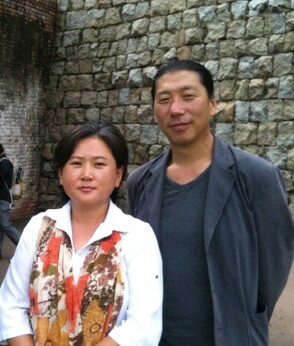hankyoreh
Links to other country sites 다른 나라 사이트 링크
Comfort women statue’s sculptor defends its place in front of Japanese embassy
The sculptor of a statue symbolizing the comfort women fired back on Dec. 29 over the South Korean government’s controversial agreement to “make efforts to resolve” Japan’s issues with its location in front of the Japanese embassy in Seoul.

“If Japan were sincerely apologetic and remorseful, it should be putting a statue like this in front of its government complex in Tokyo,” said Kim Woon-sung, the 51-year-old artist who created the statue of a young girl four years ago.
“The very idea of taking down the statue as a precondition [for an apology] is dishonest,” Kim contended.
Kim first went to the Korean Council for the Women Drafted for Military Sexual Slavery by Japan in 2011 to express his wish to help the survivors as an artist. He considered flowers, butterflies, and other designs before an idea from his wife Kim Seo-gyeong, 50, led him to create a sculpture expressing the women’s wish to reclaim the lost dreams of their childhood.
Working together with funds raised from the public, the couple developed the current statue, which was unveiled on Dec. 14, 2011, for the thousandth regular Wednesday demonstration in front of the embassy to demand an apology and compensation from Tokyo.
“What other country would use taking down a symbol as a bargaining tactic?” Kim Seo-gyeong wondered.
“It feels like we’re being disregarded as citizens.”
Japan has voiced objections through various diplomatic channels ever since the statue went up in front of the embassy in the Junghak neighborhood of Seoul’s Jongno district, citing terms regarding the “peace of overseas missions” according to international law. In the past, Seoul has defended the statue’s erection as being a “civilian effort.”
But in a joint press conference with Japan on Dec. 28, it declared that it would be “working toward an appropriate resolution through discussions with the relevant groups.”
Kim Woo-sung predicted that Japan’s demands wouldn’t stop at the statue’s relocation.
“They’re building a new embassy right now, and they’re going to keep trying to get rid of the statue before it opens [in 2020],” he said.
“So many of the [survivors] have passed away already. Once the symbol of the young girl statue is gone, they’re going to use the same argument to try to ban the Wednesday demonstrations,” he argued.
Kim went on to say that “another meaning of the statue is that the South Korean government should be reflecting on and examining its own actions.”
“Would the people have suffered in this way had it been a normal country?” he asked.
“It’s nonsense for the South Korean government to talk as though it can do something about the statue’s relocation by talking to the victims,” he added.
By Park Su-ji, staff reporter
Please direct questions or comments to [english@hani.co.kr]

Editorial・opinion
![[Column] Season 2 of special prosecutor probe may be coming to Korea soon [Column] Season 2 of special prosecutor probe may be coming to Korea soon](https://flexible.img.hani.co.kr/flexible/normal/500/300/imgdb/original/2024/0426/3317141030699447.jpg) [Column] Season 2 of special prosecutor probe may be coming to Korea soon
[Column] Season 2 of special prosecutor probe may be coming to Korea soon![[Column] Park Geun-hye déjà vu in Yoon Suk-yeol [Column] Park Geun-hye déjà vu in Yoon Suk-yeol](https://flexible.img.hani.co.kr/flexible/normal/500/300/imgdb/original/2024/0424/651713945113788.jpg) [Column] Park Geun-hye déjà vu in Yoon Suk-yeol
[Column] Park Geun-hye déjà vu in Yoon Suk-yeol- [Editorial] New weight of N. Korea’s nuclear threats makes dialogue all the more urgent
- [Guest essay] The real reason Korea’s new right wants to dub Rhee a founding father
- [Column] ‘Choson’: Is it time we start referring to N. Korea in its own terms?
- [Editorial] Japan’s rewriting of history with Korea has gone too far
- [Column] The president’s questionable capacity for dialogue
- [Column] Are chaebol firms just pizza pies for families to divvy up as they please?
- [Column] Has Korea, too, crossed the Rubicon on China?
- [Correspondent’s column] In Japan’s alliance with US, echoes of its past alliances with UK
Most viewed articles
- 1‘We must say no’: Seoul defense chief on Korean, USFK involvement in hypothetical Taiwan crisis
- 2After election rout, Yoon’s left with 3 choices for dealing with the opposition
- 3Why Kim Jong-un is scrapping the term ‘Day of the Sun’ and toning down fanfare for predecessors
- 4AI is catching up with humans at a ‘shocking’ rate
- 5Two factors that’ll decide if Korea’s economy keeps on its upward trend
- 6[Column] Park Geun-hye déjà vu in Yoon Suk-yeol
- 7Division commander ordered troops to enter raging flood waters before Marine died, survivor says
- 8Gangnam murderer says he killed “because women have always ignored me”
- 9South Korea officially an aged society just 17 years after becoming aging society
- 10No good, very bad game for Korea puts it out of Olympics for first time since 1988